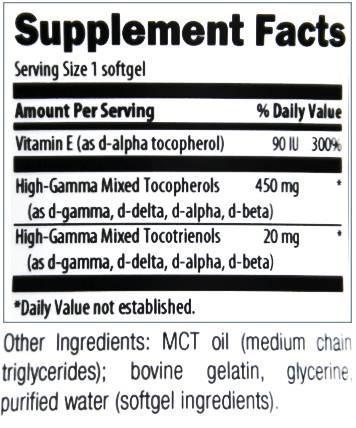Travis
Member
- Joined
- Jul 14, 2016
- Messages
- 3,189
We now have 2 worthy Vit E supplements. High Gamma in MCT oil and dry Vit E succinate and both can be taken on the same day. So my original question "Is Supplementing Vitamin E actually bad for you" is NOT if you are taking the right kind. Choice your Vit E carefully...not synthetic and not in PUFA oil and not alpha only. This thread has been a great education on Vit E.
Yes: Taking 'vitamin E' is only harmful if you consume enough α-tocopherol to inhibit γ-tocopherol assimilation, yet taking them together is never a bad thing. The anticancer effect of vitamin E succinate however appears to be transcriptional, having little to do with α-tocopherol's classic functions and everything to do with calcium. Other calcium ionophores cause similar cell changes, and so does anything which increases intracellular cAMP. It has been shown that the 'calcium response element' is identical to the 'cAMP response element,' implying that cAMP activates transcription—through CREB—only to the degree that it increases intracellular calcium.
Sheng, M. "Membrane depolarization and calcium induce c-fos transcription via phosphorylation of transcription factor CREB." Neuron (1990)
It has also been shown that the androgen receptor (AR) associates with CREB binding protein (CBP)—an unfortunate name since CREB already has 'binding protein' in its acronym, making the fully-expanded construct sound ridiculous (cAMP response element binding protein binding protein). The CBP increases the transcriptional activity of the androgen receptor by dimerizing with it, and it has been shown that other transcription factors compete for CBP (especially CREB).
Frønsdal, K. "CREB binding protein is a coactivator for the androgen receptor and mediates cross-talk with AP-1." Journal of Biological Chemistry (1998)
So this is another way that Ca²⁺ should reduce the transcriptional activity of the androgen receptor, by inducing CREB's migration to the nucleus and subsequent CBP dimerization; since the amounts of this transcription factor are limited, this would mean that other transcription factors that normally heterodimerize with it—such as the androgen receptor—would have reduced activity for encoding certain genes. This could explain the reduced levels of androgen receptor mRNA after α-tocopherol succinate, and partially explain the reduced activity of the protein it encodes (which can partially be explained by Ca²⁺-dependent association of AR with calmodulin).
So intracellular Ca²⁺ reliably reduces androgen activity while it induces transcription of other genes, such as the Ca²⁺-related vitamin D receptor (VDR). Vitamin E succinate is a safe calcium ionophore, and even in the event of the succinate bond being cleaved-off it would still be available to inhibit lipid peroxidation in the membrane and mitochondria (with succinate being fed into the citric acid cycle). Since some α-tocopherol succinate would most certainly become α-tocopherol within the body, then taking γ-tocopherol at the same time would eliminate the only real negative side-effect of 'vitamin E.' Taking γ-tocopherol will also reliable reduce reactive nitrogen species:
Cooney, R. "Gamma-tocopherol detoxification of nitrogen dioxide: superiority to alpha-tocopherol." Proceedings of the National Academy of Sciences (1993)
...subsequent prostaglandin formation:
Beharka, A. "Mechanism of vitamin E inhibition of cyclooxygenase activity in macrophages from old mice: role of peroxynitrite." Free Radical Biology and Medicine (2002)
...and cancer consequent of prostaglandin formation:
Castellone, M. "Prostaglandin E₂ promotes colon cancer cell growth through a Gs-axin-ß-catenin signaling axis." Science (2005)
Campbell, S. "Development of gamma (γ)-tocopherol as a colorectal cancer chemopreventive agent." Critical reviews in oncology/hematology (2003)
Campbell, S. "Development of gamma (γ)-tocopherol as a colorectal cancer chemopreventive agent." Critical reviews in oncology/hematology (2003)
Last edited:


